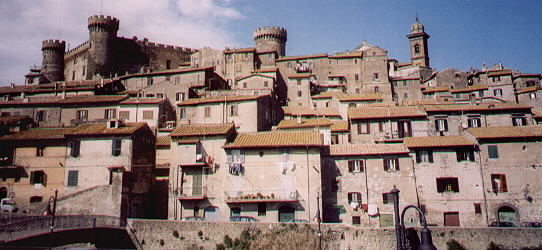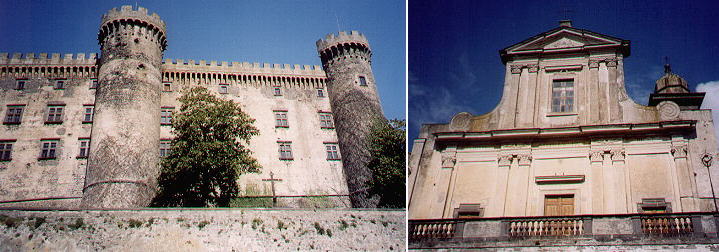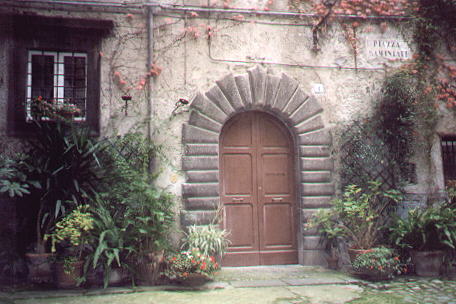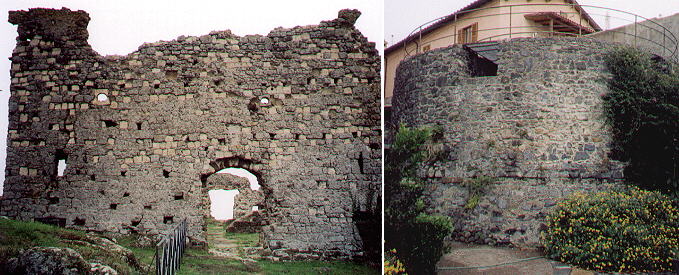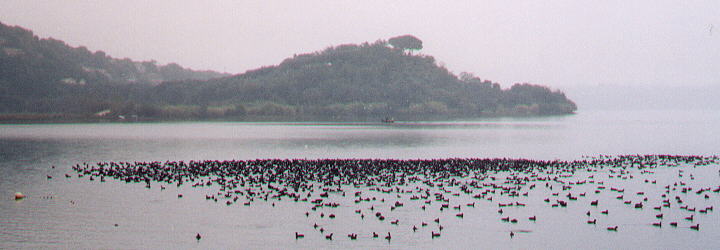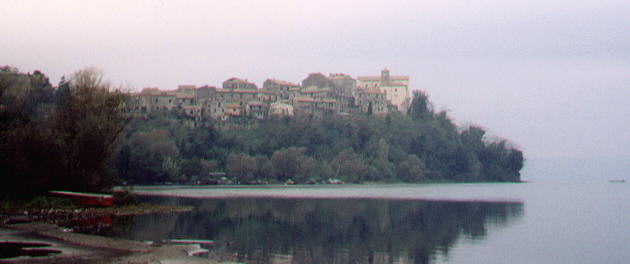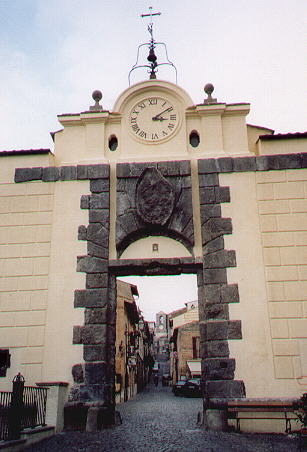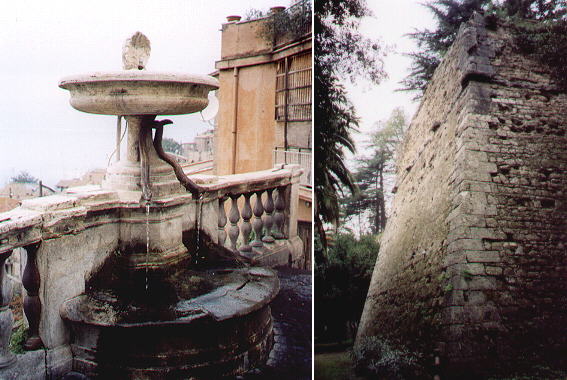  Ferdinand Gregorovius' Walks - Bracciano, Trevignano and Anguillara
Ferdinand Gregorovius started his short account about his visit to the Orsini Castle in Bracciano (Das Schloss der Orsini in Bracciano) by describing the road
he followed to reach Bracciano: Via Claudia which branches off Via Cassia a few miles north of Rome and rejoins it near
Capranica after having bordered the western side of the Lake of Bracciano. Gregorovius was struck by the desolation
of the countryside due to the febbri (fevers) at the time attributed to the unwholesome atmosphere caused by the exhalations of marshes,
hence malaria (mal aria = bad air). He found the desolation of the countryside in sharp contrast to the beauty of the lake, encircled
by low mountains and with three little towns (Bracciano, Trevignano and Anguillara) designing a perfect triangle on its shores.
In his pages devoted to Genazzano and other little towns south of Rome, Gregorovius made several references to the Colonna family; in this page he talks about their rivals: the Orsini, whose possession of Bracciano he traced back to the year 1234 (in the background of this page you can see the coat of arms of the Orsini in one of the gates of their castle in Bracciano). In 1419 Pope Martinus V Colonna (1417-31) confirmed the Orsini rule over Bracciano and Anguillara. Bracciano is dominated by the castle built between 1470 and 1485 by Napoleone Orsini and his son Gentile Virginio. In 1497 Giovanni di Candia, son of pope Alexander VI Borgia (1492-1503), repeatedly attacked the castle but the Orsini repelled the assailants and so they did again a few years later when Cesare Borgia, another son of the pope, made another attempt to take the castle.
Gregorovius wrote this account for a German newspaper and he knew that his bourgeois readers were fond of love and death stories. To please them he briefly described the life of Paolo Giordano Orsini, who in 1571 bravely fought at Lepanto. Paolo Giordano married Isabella de' Medici, daughter of the Grand Duke Cosimo I. In 1576, having heard rumours about the unfaithfulness of Isabella, Paolo Giordano did not hesitate to strangle her with his own hands: this was called in Italian delitto d'onore and it was excused by the law as a legitimate fit of temper. In 1583 Paolo Giordano fell in love with Vittoria Accoramboni, the wife of Francesco Mignucci, nephew of Cardinal Felice Peretti. One night Francesco Mignucci received a request for help from one of his brothers-in-law and accompanied by a servant he left home: he was caught in an ambush near Monte Cavallo and killed. A few days after the funeral, Vittoria Accoramboni and her mother left Rome and went to live with Paolo Giordano Orsini in Bracciano. All evidence, including the confession of one of the hired assassins, indicated Paolo Giordano to be the commissioner of the killing, but the weak pope Gregorius XIII (1572-85) did not dare to prosecute an Orsini. He did however forbid him to marry Vittoria. At the death of the pope Paolo Giordano Orsini thought he could marry Vittoria: the wedding took place the same day the cardinals elected the new pope: their choice fell on Cardinal Felice Peretti who became Pope Sixtus V.
Paolo Giordano Orsini asked for a private audience with the pope, during which he professed his loyalty to him. Sixtus V reassured him: whatever offence he had perpetrated against Cardinal Peretti was forgiven, but no offence to Sixtus V would have been tolerated and he requested Paolo Giordano Orsini to stop giving asylum to criminals and bandits in his fortress of Bracciano. The Orsini was impressed by the calm and firmness of the pope and he preferred to leave Bracciano with his wife taking as an excuse the need to cure himself at Abano, near Padova in the Republic of Venice. Here he died in November 1585 after having left a small fortune to his wife to the detriment of the other members of the family. Vittoria did not have time to spend her money: the night of Christmas Eve her palace in Padova was assaulted by a gang of assassins hired by the Orsini. Vittoria died like her first husband: stabbed to death. Gregorovius did not give a full account of the death of Vittoria as he knew that most of his readers were aware of its details having read the short novel Vittoria Accoramboni by Stendhal. In 1696 the last of the Orsini (of Bracciano) sold the castle to Livio Odescalchi, nephew of Pope Innocentius XI (1676-89) and the castle still belongs to the Odescalchi.
Trevignano Trevignano is located in the northern part of the lake on a little promontory closing a circular bay made by a small crater.
The Orsini had fortified also Trevignano, but the castle was taken in 1505 by Cesare Borgia and it was never rebuilt. While Bracciano is about a mile from the lake, Trevignano is right on it and it has a little harbour protected by a round tower.
A misty day may not be perfect for taking pictures, but lakes gain from this kind of weather. Anguillara Two eels are the symbol of Anguillara and many think the town was named after them (anguilla in Italian), but the origin of the name is due to the angle made by the coastline at that point.
Today Anguillara has a large population of commuters living between the lake and the outskirts of Rome, but its historical little center is untouched.
The gate of Anguillara allows a view over the main street going up to the church. The large coat of arms over the gate is unreadable.
The only fountain of Anguillara is dedicated to the eels, which, cooked in various manners, are the main speciality of the local restaurants and trattoria. The entrance to Anguillara is protected by a little castle, which is still well preserved. Introductory page on Ferdinand Gregorovius Other walks: Roman Campagna: Palestrina Genazzano Paliano Anagni The Ernici Mountains: Ferentino Alatri The Volsci Mountains: Valmontone Segni Norma Cori On the Latin shores: Anzio Nettuno and Torre Astura Circe's Cape: Terracina San Felice Subiaco, the oldest Benedictine monastery See my Home Page on Baroque Rome or my Home Page on Rome in the footsteps of an XVIIIth century traveller |
All images © 1999 - 2003 by Roberto Piperno. Write to romapip@quipo.it
